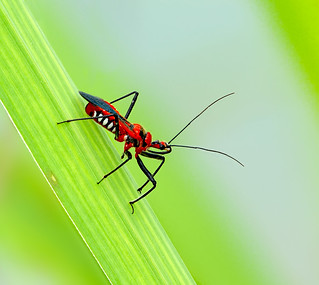Insects
can provide a sustainable and environmentally-friendly option for animal feed,
in addition to already being a mainstay of human diets for 2 billion people
worldwide, FAO Assistant Director-General Eduardo Rojas-Briales told an international
gathering of researchers in The Netherlands.
Rojas
spoke during the opening session of the conference, “Insects to Feed
the World,” jointly organized by Wageningen University and the UN
agency. More than 400 participants from 45 countries have gathered for the
14-17 May event to examine the current status and future potential of insects
as food and feed.
“The time is ripe to think about alternative sources of food
in view of a growing world population, climate change threats and persisting
hunger in many parts of the world,” said Rojas, who oversees FAO’s work in
forestry and related food systems and livelihoods. Wild foods contribute to the
food security of millions of people living in and around forests and most of
the insects consumed by one-third of the world’s people are collected from the
wild.
“Certainly
insects alone will not solve the world’s food security challenges but it would
be absurd not to mobilize their full potential in the fight against hunger and
malnutrition.”
“Raising
insects for feed is an environmentally friendly and efficient way of producing
animal feed,” said Rojas. “Insects can be fed on bio-waste, compost and animal
slurry, and can transform these into high-quality protein for animal feed.”
“Recognizing
the global potential of insects for food in this conference is not to advocate
a change in the food patterns of the other two-thirds of the global population
that is not used to eating insects, but to ensure that those who consume
insects can continue to do so in the future in a sustainable way, and to
highlight the different potential contributions insects can make to food
security in the future,” Rojas said.
He
added that the challenge of feeding a projected 9 billion people in a
sustainable way by the year 2050 will “never be achieved based on one single
measure, but is only possible by a convergence of perseverant measures that
complement each other.”
Tiny
champions
 |
| Insect (Photo credit: Gnilenkov Aleksey) |
Rojas
mentioned bees as a prime example of the variety of ways in which insects
contribute to food security. Bees provide honey but they are also the
predominant and most economically important group of pollinators in most
geographical regions of the globe, supporting pollination of 71 of the 100 crop
species that provide 90 percent of the world’s food. Also, bees are among the
most commonly consumed insects in some parts of the world.
In addition to
raising awareness of the potential of insects in sustainable diets and food
production, conference participants plan to discuss a variety of related
issues, including data-gathering, nutritional analysis, and regulatory and
research considerations, among others.
Rojas said the
international scientific community could make “important contributions by
generating the right momentum to overcome the still-existing bottlenecks and to
unlock the full potential of insects for food and feed.”
The Global Miller
This blog is maintained by The Global Miller staff and is supported by the magazine GFMT which is published by Perendale Publishers Limited.


No comments:
Post a Comment